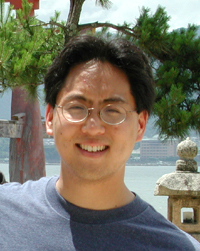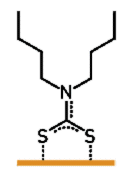A pincer-like grip on metal surfaces could make a century old class of compounds useful in developing twenty-first Century sensor technology, according to US scientists.
For years, scientists have been trying to find ways to make useful molecules stick to metal surfaces. There are many reasons for wanting to do so as novel technologies might be made possible – different kinds of sensors for environmental, medical, and molecular biology applications, and more recently to assemble molecules onto nanoparticles for exciting applications in nanotechnology. So far, researchers have relied on sulphur-containing organic compounds, known as thiols, to act as anchors on metal surfaces. Thiols are a popular way to functionalize metal surfaces and nanoparticles but their applications often run into problems, such as a tendency of thiols to slide off the metal surface.

Alex Wei
Now, Alexander Wei of Purdue University and colleagues have discovered that coupling amines with carbon disulphide can produce an anchor onto gold surfaces that is more steadfast than thiols. These anchoring molecules, known as dithiocarbamates (DTCs), have been known and used by chemists for almost a century, yet have somehow been overlooked in the gold rush for nanotechnology and biosensing. The discovery by US scientists could turn this venerable chemistry into cutting-edge sensor technology.
Functionalizing metal surfaces with amines via DTCs should allow us to expand the range of molecules which can be incorporated into sensors for the biotech field, explains Wei. In addition, the DTCs may have the simple but critical advantage of staying put once they have bound to the surface. A typical thiol has one sulphur atom, so it sticks to gold rather like a pin to a pincushion. DTCs act more like a pincer, so we expect them to have a tighter grip on the metal. For example, when a gold surface coated with DTCs was exposed to conditions known to completely displace thiols from the surface, the DTC layer remained essentially intact. Such ligands may be well suited for functionalizing surfaces exposed to relatively harsh environmental conditions, suggests Wei.

A DTC pincer can hang on to a gold surface more effectively than a thiol pin
Further reading
J. Am. Chem. Soc., 2005, 127, 7328-7329
http://dx.doi.org/10.1021/ja050432f
Wei Research Group
http://www.chem.purdue.edu/awei/
Alexander Wei
http://www.chem.purdue.edu/people/faculty/faculty.asp?itemID=67
Suggested searches
thiols
amines